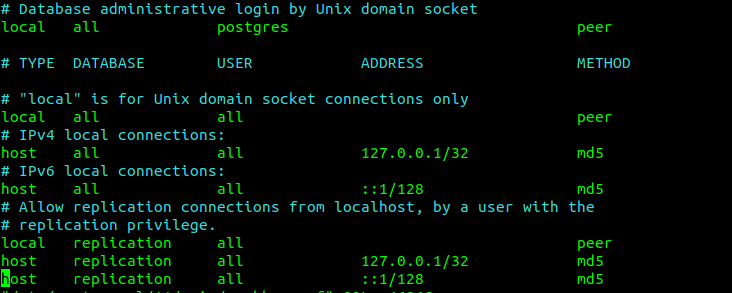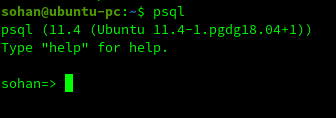PostgreSQL is a powerful open-source relational database system featuring high-performance capabilities, including enterprise-class performance, triggers, and ACID (Atomicity, Consistency, Isolation, Durability) compliance. These advanced features make PostgreSQL an excellent choice for complex applications.
PostgreSQL Installation:
In this tutorial, we will download the latest version of PostgreSQL from its official website: PostgreSQL Official Website
While PostgreSQL is available in Ubuntu’s default repository, using the official PostgreSQL apt repository allows for installation of a specific version with ease.
Using the apt Repository:
To utilize the apt repository, follow these steps:
Step 1: Choose Your Ubuntu Version
For this guide, we use Ubuntu version Bionic (18.04).
Create the PostgreSQL repository file:
nano /etc/apt/sources.list.d/pgdg.listAdd the following line to the pgdg.list file:
deb http://apt.postgresql.org/pub/repos/apt/ bionic-pgdg main
Note: If you are using a different Ubuntu version, replace ‘bionic’ with your version’s name. Import the repository signing key and update the package lists:
wget --quiet -O - https://www.postgresql.org/media/keys/ACCC4CF8.asc | sudo apt-key add -
sudo apt-get update
Step 2: Install PostgreSQL
Install the latest PostgreSQL server using the following command:
sudo apt-get install postgresql postgresql-contrib
The PostgreSQL server should start automatically after installation.
Step 3: Verify PostgreSQL Installation
Check the PostgreSQL service status with:
systemctl status postgresql
Verify the PostgreSQL connection and server version:
sudo -u postgres psql -c "SELECT version();"
The above command uses psql to connect to PostgreSQL and display the server version.
version ----------------------------------------------------------------------------------------------------------------------------------- PostgreSQL 11.4 (Ubuntu 11.4-1.pgdg18.04+1) on x86_64-pc-linux-gnu, compiled by gcc (Ubuntu 7.4.0-1ubuntu1~18.04.1) 7.4.0, 64-bit
Using PostgreSQL Roles and Authentication Methods
PostgreSQL employs roles for database access permissions, applicable for individual users or user groups.
PostgreSQL supports multiple authentication methods, with the most commonly used being:
- Trust: Allows a role to connect without a password, specified in
pg_hba.conf. - Password: Requires a password for database connection.
- Ident: Functions on TCP/IP connections only.
- Peer: Used for local connections only.
Edit the pg_hba.conf file to modify authentication methods:
nano /etc/postgresql/11/main/pg_hba.confBy default, PostgreSQL uses the peer authentication method. Change peer to your preferred method.

During installation, a default ‘postgres’ superuser account is created in PostgreSQL, similar to the root user in MySQL, and also created in Ubuntu.
Connecting to PostgreSQL
Connect to PostgreSQL using the following command:
sudo -i -u postgres
Enter the PostgreSQL prompt by typing:
psql
To connect to the database server directly, use:
sudo -u postgres psql
Creating Roles and Databases in PostgreSQL
To create a new role:
root@ubuntu-pc:/home# sudo -u postgres createuser --interactive Enter name of role to add: sohan Shall the new role be a superuser? (y/n) y
To list existing user roles:
postgres=# \du
Or from the postgres prompt:
SELECT rolname FROM pg_roles;

To drop an existing user role:
postgres=# DROP ROLE sohan; DROP ROLE
Creating a PostgreSQL Database
Log in as the postgres account and create a database:
postgres@ubuntu-pc:~$ createdb dummu
Alternatively, from a normal Ubuntu user:
sudo -u postgres createdb dummu
Logging into PostgreSQL Prompt Using a New Role
Create a new system user:
sudo adduser sohan
Log in using the new role:
sudo -u sohan psql
Or use:
sudo -i -u sohan psql

Connect to a different database:
psql -d dummu
To get database information:
dummu=> \conninfo
Output You are connected to database "dummu" as user "sohan" via socket in "/var/run/postgresql" at port "5432"
Creating Tables in PostgreSQL
Create a table with:
CREATE TABLE dummu( user_id serial PRIMARY KEY, username VARCHAR (50) UNIQUE NOT NULL, password VARCHAR (50) NOT NULL, email VARCHAR (355) UNIQUE NOT NULL, created_on TIMESTAMP NOT NULL, last_login TIMESTAMP);
Display the table:
\d

The dummu_user_id_seq table tracks the next number in sequence.
Only display table names without sequence:
\dt
sohan=> \dt
Output List of relations Schema | Name | Type | Owner --------+--------+-------+------- public | dummu | table | sohan
Adding Data into the Table
Insert data into the dummu table:
Insert into dummu(user_id,username,password,email,created_on,last_login) values (1,'sohan','123456','sohan@gmail.com','2019-06-24 11:11:11','2019-06-24 11:11:11');
Fetch data from the dummu table:
SELECT * FROM dummu;

Deleting a Column from the Table
Delete data from the table:
DELETE FROM dummu WHERE email = 'sohan@gmail.com';

Altering PostgreSQL Tables
Modify the table with the ALTER query:
ALTER TABLE dummu DROP email;
This will remove the email field from the dummu table.
Verify by:
SELECT * FROM dummu;
Output:
user_id | username | password | created_on | last_login
--------+----------+----------+----------------+---------------
1 | sohan | 123456 | 2019-06-24 11:11:11 | 2019-06-24 11:11:11
Updating Data in a Table
To update table data, execute the following command:
UPDATE dummu SET password = 'postgres' WHERE username = 'sohan';
Verify changes with:
SELECT * FROM dummu;
Output:
user_id | username | password | created_on | last_login
--------+----------+----------+----------------+---------------
1 | sohan | postgres | 2019-06-24 11:11:11 | 2019-06-24 11:11:11
In this tutorial, we covered PostgreSQL installation, role and database creation, and basic database commands.
Frequently Asked Questions (FAQ)
Q: Can I use PostgreSQL on older Ubuntu distributions?
A: Yes, PostgreSQL supports a wide range of Ubuntu versions. Just make sure to replace ‘bionic’ with your specific version’s name in the repository URL.
Q: How do I enable a different PostgreSQL authentication method?
A: Edit the pg_hba.conf file and replace the current method (like ‘peer’) with your desired method (‘md5’, ‘password’, etc.) and restart the PostgreSQL service.
Q: What do I do if the PostgreSQL service fails to start?
A: Check the PostgreSQL logs located in /var/log/postgresql/ or use systemctl status postgresql for additional insight into startup errors.
Q: Can I upgrade PostgreSQL without data loss?
A: Yes, ensuring a backup with tools like pg_dumpall before an upgrade is a best practice. Follow PostgreSQL’s documented upgrade procedures for data preservation.
Q: How do I connect to a PostgreSQL database from a remote system?
A: Modify postgresql.conf to listen on external interfaces and update pg_hba.conf to accept remote connections. Ensure network firewall settings permit the required database ports.
